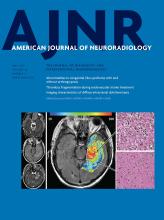Abstract
BACKGROUND AND PURPOSE: As the practice of in utero repair of myelomeningoceles becomes more prevalent, knowledge of the expected MR imaging findings has become increasingly important. Our aim was to examine neuroimaging findings with a focus on hindbrain herniation and ventricular size in fetuses with open spinal dysraphism and to compare them with postnatal imaging features in groups undergoing prenatal-versus-postnatal repair.
MATERIALS AND METHODS: Single-center retrospective analysis was performed on MRIs of fetuses with open spinal dysraphism from January 2004 through July 2015 with available postnatal imaging. One hundred two fetuses were included. Reports from available fetal ultrasound were also examined. Images were reviewed by 2 board-certified fellowship-trained pediatric neuroradiologists. Descriptive analyses were performed to demonstrate the distribution of the imaging findings.
RESULTS: Thirty-two of 102 (31.3%) fetuses underwent in utero repair of open spinal dysraphism; 68.6% (70/102) underwent postnatal repair. Ninety-four of 102 (92.2%) fetuses had cerebellar ectopia. Of those who underwent prenatal repair (26 grade 3, 6 grade 2), 81.3% (26/32) had resolved cerebellar ectopia postnatally. Of those who had severe cerebellar ectopia (grade 3) that underwent postnatal repair, 65.5% (36/55) remained grade 3, while the remaining 34.5% (19/55) improved to grade 2. The degree of postnatal lateral ventriculomegaly in those that underwent prenatal repair (20.3 ± 5.6 mm) was not significantly different from that in those that underwent postnatal repair (21.5 ± 10.2 mm, P = .53). Increased Chiari grade was significantly correlated with decreased head size for gestational age on fetal sonography (P = .0054).
CONCLUSIONS: In fetuses with open spinal dysraphism and severe Chiari II malformation that do not undergo prenatal repair, most have no change in the severity of cerebellar ectopia/Chiari grade. However, in fetuses that undergo in utero repair, most have resolved cerebellar ectopia postnatally.
ABBREVIATION:
- OSD
- open spinal dysraphism
- © 2017 by American Journal of Neuroradiology












